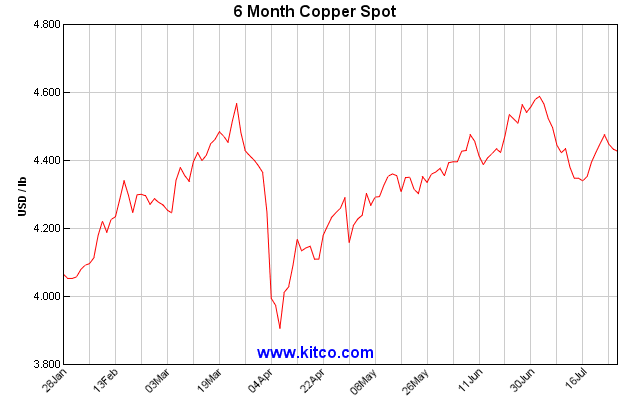
Posted on 08/22/2012 6:27:18 AM PDT by blam
The Iron Ore Futures Collapse Chart That Everyone Is Talking About
Joe Weisenthal
Aug. 22, 2012, 8:39 AM

You've probably heard the term "Dr. Copper" to describe copper's role in serving as a good bellweather of the global economy.
But all the buzz these days is about iron ore, a key ingredient in steel.
This morning, a hedge fund manager in Europe sent us this chart of front month iron ore futures over the last couple of years.

It's obviously very early, but that is one ugly chart.
Included with the chart he sent this nice, quick overview:
Iron ore is second biggest commodity traded internationally by volume (after oil). It is the main ingredient in the production of steel. China is by far the worlds #1 producer of steel and importer of iron ore (over 60% of seaborne ore goes to China).
While Wall Street focuses on Oil, Natural Gas, Copper etc., Iron ore is a huge commodity that is highly reliant on Chinese demand. While most other commodities are recovering from their lows Iron Ore is crashing. The spot peaked this year at around $150/ton in April (highs close to 190 last year). The spot now is around $105 per ton and falling fast and the futures (now fairly liquid and traded internationally) are pricing q4 below $95/ton.
The drop in the futures of over 10% this week will no doubt show up in the spot price in the next week or so. While Bloomberg, FT etc. report on moves on the spot price they are a bit oblivious to what happens on the futures (spot is a slow moving index, futures are bets on future level of index). While Wall Street doesn't trade iron ore, the major miners
(snip)
(Excerpt) Read more at businessinsider.com ...
paraphrasing Andrew Dice Clay, “I got yer commodity super-cycle right heah!”

If Baraq wins, the coming leg down in the economy will be due to Europe, despite Baraq’s heroic efforts to save them.
If Romney wins, the coming leg down in the economy will be due to Republicans.
A big drop in iron ore consumption and price goes hand-in-hand with a drop in met coal usage and the collapse in the BDI (Baltic Dry Index).
Even the Chinese, who fouled up Dr. Copper’s record by stockpiling above their industrial needs, using it as a substitute for T-Bonds as a store of value, aren’t going to stockpile iron as a store of value. If steel consumption is forecast to be down, iron usage and price drop.
Not a good indication.
I’d love to see the price of steel drop. Concrete slabs too (a component of which is steel).
I’ve got a couple of metal buildings I need to put up. :-)
A met coal mine near Trinidad, CO “temporarily” laid off most of their workforce back in June.
The “temporary” idea was to give the market 60 days to clear the “surplus” and demand would pick up again.
Well... it’s been more than 60 days and the mine isn’t re-hiring - nor do they think they will anytime soon.
This mine’s output is shipped in toto to China.
“...the buzz these days is about iron ore, a key ingredient in steel.”
Um, earth to Joe: Iron is THE key ingredient in steel.
You can have steel without carbon, moly, chrome, nickel, vanadium, etc - all those other alloying elements, but no iron means no steel, period, end of discussion.
Re Chinese investment:
If these investments are large, and funded, the demand for, and the price of, iron will rise. Time will tell—there’s a lot of conflicting information being written on what the Chinese situation is.
Also, these projects will have a lead-time from authorization to buildout of a couple of years.
It never occurred to me that concrete slabs were a commodity product but I suppose they are. Are their standard sizes and structural specifications?
I know the Chinese have invested several %billion in taconite mines in N. Mn over the past 10 years or so. Something of a miny boom up there.
Does this mean China has enough ghost cities now?
Note: You can’t have steel without carbon, that’s
what makes it steel. Otherwise it’s just wrought iron.
Cast Iron is when you have too much carbon.
I have some land near the New Elk mine. It was closed when I bought it but there was a lot of activity the past few years. Sounds like that is ending again.
Steel consumption is a pretty good indicator of construction and durable-goods production (cars, appliances, machinery, etc). Looks like people are sharply reducing durable-goods orders, deciding to make what they have last a little longer before replacement.
>> It never occurred to me that concrete slabs were a commodity product but I suppose they are. Are their standard sizes and structural specifications?
No, the slab itself is not a commodity as far as I know. The materials that go into a slab (cement and reinforcing steel) are commodities, though.
Disclaimer: Opinions posted on Free Republic are those of the individual posters and do not necessarily represent the opinion of Free Republic or its management. All materials posted herein are protected by copyright law and the exemption for fair use of copyrighted works.